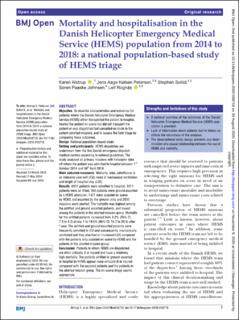| dc.contributor.author | Alstrup, Karen | |
| dc.contributor.author | Petersen, Jens Aage Kølsen | |
| dc.contributor.author | Sollid, Stephen J. M. | |
| dc.contributor.author | Johnsen, Søren Paaske | |
| dc.contributor.author | Rognås, Leif Kåre | |
| dc.date.accessioned | 2023-01-16T13:26:42Z | |
| dc.date.available | 2023-01-16T13:26:42Z | |
| dc.date.created | 2020-11-09T13:16:36Z | |
| dc.date.issued | 2020 | |
| dc.identifier.citation | Alstrup, K., Petersen, J. A. K., Sollid, S., Johnsen, S. P., & Rognås, L. (2020). Mortality and hospitalisation in the Danish Helicopter Emergency Medical Service (HEMS) population from 2014 to 2018: a national population-based study of HEMS triage. BMJ open, 10(8), e038718. | en_US |
| dc.identifier.issn | 2044-6055 | |
| dc.identifier.uri | https://hdl.handle.net/11250/3043755 | |
| dc.description.abstract | Objective To describe characteristics and outcomes for patients where the Danish Helicopter Emergency Medical Service (HEMS) either transported the patient to hospital, treated the patient on scene but did not transport the patient or was dispatched but cancelled en route to the patient (aborted mission), and to assess the field triage by comparing these outcomes.
Design National population-based study.
Setting and participants HEMS dispatches are undertaken from the five Danish emergency dispatch medical centres according to national guidelines. The study analysed all primary missions with helicopter take off where the patient was admitted to hospital between 1st October 2014 and 30th April 2018.
Main outcome measures Mortality rates, admittance to an intensive care unit (ICU), need of mechanical ventilation and length of hospital stay (LOS).
Results 6931 patients were admitted to hospital; 3311 patients were air lifted, 164 patients were ground escorted by a HEMS physician, 1421 were assisted on scene by HEMS, but escorted by the ground units and 2035 missions were aborted. The mortality was highest among the airlifted and ground escorted patients, and lowest among the patients in the aborted mission group. Mortality for the airlifted patients increased from 8.2% (95% CI; 7.3 to 9.2) at day 1 to 19.5% (95% CI; 18.2 to 20.9) after 1 year. The airlifted and ground escorted patients were frequently admitted to ICU and subsequently mechanically ventilated and they also had an increased LOS compared with the patients only assisted on scene by HEMS and the patients in the aborted mission group.
Conclusion Patients to whom HEMS are dispatched are often critically ill or injured and have a relatively high mortality. The patients airlifted or ground escorted to hospital by HEMS appear more critically ill or injured compared with the assisted patients and the patients in the aborted mission group. The on-scene triage seems appropriate. | en_US |
| dc.language.iso | eng | en_US |
| dc.publisher | BMJ Publishing Group | en_US |
| dc.rights | Navngivelse 4.0 Internasjonal | * |
| dc.rights.uri | http://creativecommons.org/licenses/by/4.0/deed.no | * |
| dc.title | Mortality and hospitalisation in the Danish Helicopter Emergency Medical Service (HEMS) population from 2014 to 2018: a national population-based study of HEMS triage | en_US |
| dc.type | Peer reviewed | en_US |
| dc.type | Journal article | en_US |
| dc.description.version | publishedVersion | en_US |
| dc.rights.holder | the authors | en_US |
| dc.subject.nsi | VDP::Medisinske Fag: 700::Helsefag: 800 | en_US |
| dc.source.volume | 10 | en_US |
| dc.source.journal | BMJ Open | en_US |
| dc.source.issue | 8 | en_US |
| dc.identifier.doi | 10.1136/bmjopen-2020-038718 | |
| dc.identifier.cristin | 1846160 | |
| dc.source.articlenumber | e038718 | en_US |
| cristin.ispublished | true | |
| cristin.fulltext | original | |
| cristin.qualitycode | 1 | |

